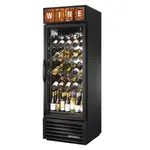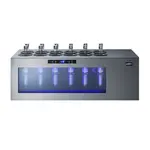
The Ultimate Guide for Restaurant Owners: Optimizing Wine Displays and Storage
Wine plays a crucial role in the dining experience, enhancing both the meal and the ambiance of any establishment. For restaurant owners, showcasing wine isn't just about storage—it's about creating a visual centerpiece that adds to the dining experience, all while preserving the integrity of the wine itself. In this guide, we'll explore what restaurant owners need to know about creating effective wine displays, from choosing the right restaurant wine display to maintaining a wine wall in the dining room.
The Importance of a Restaurant Wine Display
A restaurant wine display is more than just a storage solution—it's a statement. It reflects the restaurant's identity, its dedication to quality, and its understanding of the art of wine. A well-thought-out wine display can elevate the dining experience, encourage wine sales, and become a focal point in your restaurant's design.
Designing a Wine Display in Your Restaurant
When designing a wine display in a restaurant, it's essential to consider both aesthetics and functionality. The display should be attractive to customers, encouraging them to explore the wine list, while also preserving the wine at the right temperature and humidity.
Choosing the Right Location
The location of your restaurant wine display is crucial. Ideally, it should be in a place where it catches the eye of diners but is also accessible to staff. Common locations include:
- Entrance Areas: A wine display near the entrance can immediately set the tone for the dining experience.
- Dining Room: A wine wall in the dining room can serve as a dramatic backdrop, integrating wine into the overall ambiance.
- Bar Areas: If your restaurant has a bar, incorporating a wine display can enhance the appeal of the space.
Wine Wall or Wine Cellar?

A restaurant wine wall and a dining room wine cellar are two popular choices for displaying wine. Each offers unique benefits:
- Wine Wall: A wine wall is a vertical display that can be a stunning visual feature. It's ideal for restaurants with limited space or for those who want to create a modern, minimalist look. The restaurant wine wall can be designed with glass, wood, or metal, and can be either temperature-controlled or simply a decorative feature.
- Wine Cellar: A dining room wine cellar offers more storage space and is perfect for restaurants with an extensive wine list. This option is more traditional and provides a luxurious feel, making it suitable for fine dining establishments. A wine cellar requires careful planning to ensure it maintains the correct temperature and humidity levels for wine preservation.
Materials and Design
The materials you choose for your restaurant wine display cabinet or wine wall play a significant role in the overall look and feel. Some popular choices include:
- Glass: Glass displays offer a sleek, modern look, allowing customers to view the wine without direct access. This can be paired with LED lighting to highlight the bottles.
- Wood: Wood gives a warm, traditional feel and is often used in wine cellars. It’s versatile, coming in various finishes that can complement your restaurant's decor.
- Metal: Metal displays are durable and offer a contemporary aesthetic. They are often used in minimalist or industrial-style restaurants.
Lighting
Lighting is a crucial element in any restaurant wine display. It should highlight the wine without causing damage. LED lights are a popular choice because they do not emit heat, which can affect the wine's quality. The lighting should be soft yet focused, drawing attention to the wine without overpowering the dining experience.
Wine Storage Solutions for Restaurants
Proper wine storage for restaurants is essential to ensure that the wine remains in optimal condition. Here are some key considerations:
Temperature Control
Wine should be stored at a consistent temperature to preserve its quality. The ideal storage temperature for wine is between 45°F and 65°F (7°C to 18°C). Red wines typically do well at the higher end of this range, while white wines and sparkling wines prefer the lower end.
Investing in a climate-controlled restaurant wine display cabinet or wine cellar is essential if you plan to store wine for extended periods. These systems regulate both temperature and humidity, ensuring that your wine remains in perfect condition.
Humidity
The humidity level in your restaurant wine storage should be maintained at around 60-70%. Low humidity can cause the corks to dry out, leading to oxidation and spoilage of the wine. High humidity, on the other hand, can encourage mold growth on the labels and corks.
Avoiding Vibrations
Wine should be stored in a vibration-free environment. Constant vibrations can disturb the sediment in the bottle, affecting the wine's flavor and texture. Ensure that your restaurant wine storage is in a stable location away from kitchen appliances or high-traffic areas.
Light Exposure
Wine should be stored away from direct sunlight or bright indoor lighting. UV rays can degrade and prematurely age wine, so your wine display should either have UV-resistant glass or be placed in a dimly lit area.
Maximizing the Potential of Your Wine Display

To get the most out of your restaurant wine display, consider these strategies:
Curate Your Selection
The wines you choose to display should reflect your restaurant's theme and clientele. For a high-end restaurant, showcasing premium wines can enhance the perception of luxury. For a more casual dining experience, a mix of affordable and mid-range wines might be more appropriate.
Rotate Your Display
Keep your restaurant wine wall or display fresh by rotating the selection regularly. This encourages repeat customers to explore new options and keeps your staff engaged in learning about different wines.
Use the Display as a Marketing Tool
Your wine display can be a powerful marketing tool. Feature special promotions, such as discounts on wines displayed or pairing suggestions with your menu. Educate your staff to talk knowledgeably about the wines on display, as their recommendations can significantly influence sales.
Wine and Food Pairings
One effective way to boost wine sales is to highlight wine and food pairings within your restaurant wine display. Feature a section dedicated to wines that pair well with popular dishes on your menu. This not only enhances the dining experience but also guides customers in making a choice, which can increase sales.
Offer Tastings
Use your wine display as a focal point for wine tastings or pairing events. This not only draws attention to your wine selection but also engages customers in an interactive experience. Offering tastings of wines from your wine wall in the dining room can help educate customers and staff alike, making it easier to recommend wines with confidence.
Maintaining Your Restaurant Wine Display
Once your restaurant wine display is set up, maintaining it is key to preserving both the wine and the visual appeal.
Regular Cleaning
Ensure that your restaurant wine display cabinet and wine wall are regularly cleaned. Dust and smudges can detract from the display's appearance, while any spills should be promptly addressed to prevent damage to the bottles or shelving.
Monitor Temperature and Humidity
Regularly check the temperature and humidity levels in your restaurant wine storage. Any fluctuations should be addressed immediately to prevent damage to the wine.
Inventory Management
Keep a detailed inventory of the wines in your display. This helps in managing stock levels and ensures that you can quickly reorder popular selections. It also aids in rotating the stock, so older wines are sold before newer ones.
Incorporating Wine Merchandisers and Glassware into Your Wine Display
In addition to the wine itself, integrating wine merchandisers and glassware into your restaurant wine display can enhance the overall presentation and encourage additional sales. Wine merchandisers are specially designed fixtures or displays that can be used to showcase related products, such as premium wine glasses, decanters, and other accessories. By featuring high-quality glassware alongside your wines, you not only create a more complete and appealing display but also provide customers with the opportunity to purchase items that enhance their wine-drinking experience. For instance, placing elegant wine glasses next to a wine wall in the dining room can subtly suggest a more refined experience, enticing customers to order a bottle. Additionally, offering branded or specialty glasses can be an excellent upsell, especially if they are prominently displayed alongside the wines that pair best with them. This not only adds to the aesthetic appeal of your restaurant wine display but also opens up new revenue streams through the sale of wine-related merchandise.
Conclusion
A well-designed and maintained restaurant wine display is a powerful asset for any restaurant. It not only enhances the ambiance but also boosts wine sales and customer satisfaction. By carefully considering the design, location, and storage solutions, restaurant owners can create a wine display that is both functional and visually stunning. Whether opting for a wine wall in the dining room or a more traditional restaurant wine cellar, the key is to ensure that the display aligns with the restaurant's brand and enhances the overall dining experience. With the right approach, your restaurant wine display can become a defining feature that sets your establishment apart from the competition.





